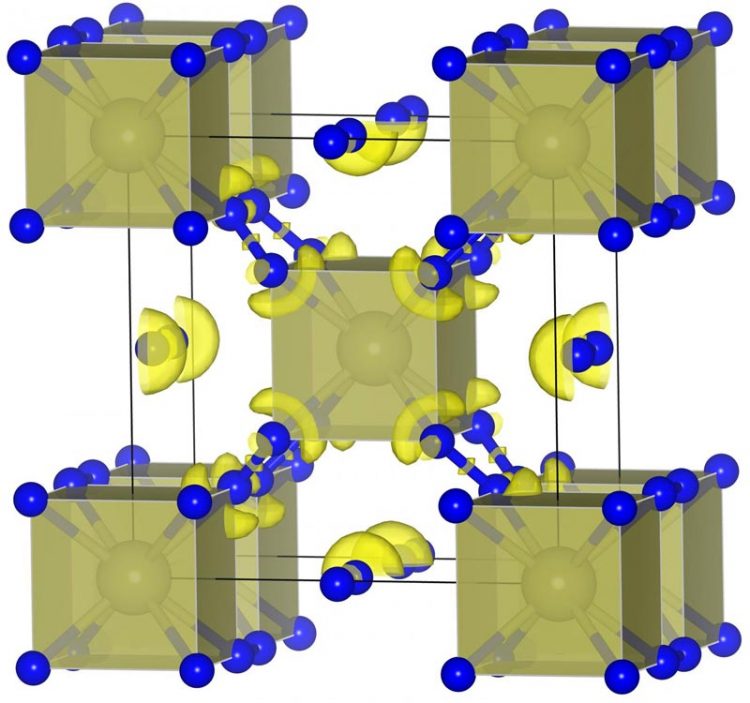Scientists predicted new high-energy compounds

This is a hafnium nitride (HfN10) structure. Credit: MIPT Press Office
Pure polymeric nitrogen is the ideal high-energy compound that packs so much energy per unit volume or mass that it could be used as a powerful explosive if it were not for gigantic pressures of its synthesis. This work shows that nitrogen polymerizes at much lower pressures in presence of metal ions, and such compounds might find practical use. The authors also predicted a range of new hafnium nitrides as well as nitrides, carbides and borides of chromium, with an unusual combination of properties (high hardness, electrical conductivity, and toughness).
Superhard materials can be divided into two main classes: compounds of boron, carbon, nitrogen and oxygen together and compounds of transition metals with boron, carbon and nitrogen. The scientists studied four systems in two simultaneously published works: hafnium-nitrogen, chromium-nitrogen, chromium-carbon and chromium-boron.
Several new materials, which can be formed at relatively low pressure, were predicted. Among them there are materials with an unusual combination of very high hardness and electrical conductivity. In particular, newly predicted carbide Cr2C should even be stable at atmospheric pressure; and researchers were able to resolve for the first time the crystal structure of a known compound Cr2N.
The most interesting finding is the chemical compound with the formula HfN10 – here, there are ten nitrogen atoms per hafnium atom. Its structure is very peculiar from a chemical point of view: The hafnium atoms and N2 molecules are sandwiched between infinite chains of nitrogen atoms. Such structure is formed under relatively low pressure of 0.23 Mbar.
According to Professor Artem R. Oganov: “This finding brings us back to one of the Holy Grails in material science, the search for polymeric nitrogen, an ideal high-energy-density material”.
The fact of the matter is that all good explosive compounds contain nitrogen – at the moment of explosion the nitrogen atoms form the extraordinary stable N2 molecule, releasing a vast amount of energy. The more nitrogen atoms in a compound, and the more unusual their bonding, the more energy will be released as a result of the explosion. Polymeric nitrogen was first predicted by American physicist C. Mailhiot in 1992 and then synthesized in 2004 by Russian physicist Michael Eremets under pressures exceeding one million atmospheres.
At such pressures only micron-sized samples can be made, which rules out any practical applications. Professor Oganov says: “Our group works on several projects related to metal polynitrides. This is a promising class of high-energy-density compounds, requiring much lower pressures than pure polymeric nitrogen (e.g., 5 times lower in case of HfN10, or even less for CrN4, and this is likely not the limit). Chemists have long dreamed about synthesising polymeric nitrogen in large quantities. We have proposed the compound class that can fulfil this dream. “
###
Two publications appeared as a result of these studies. The first author of the article published in The Journal of Physical Chemistry Letters is Alexander Kvashnin, a postdoc at Skoltech. The first author of the second article in Physical Review B is Jin Zhang, Oganov's graduate student at Stony Brook University.
The Skolkovo Institute of Science and Technology (Skoltech) is a private graduate research university. Established in 2011 in collaboration with the Massachusetts Institute of Technology (MIT), Skoltech educates global leaders in innovation, advance scientific knowledge, and fosters new technologies to address critical issues facing Russia and the world. Skoltech conducts it work integrating the best practices of the best Russian and international educational and scientific research universities. Moreover, the university pays particular attention to entrepreneurship and innovative education. Website: http://www.
Media Contact
All latest news from the category: Life Sciences and Chemistry
Articles and reports from the Life Sciences and chemistry area deal with applied and basic research into modern biology, chemistry and human medicine.
Valuable information can be found on a range of life sciences fields including bacteriology, biochemistry, bionics, bioinformatics, biophysics, biotechnology, genetics, geobotany, human biology, marine biology, microbiology, molecular biology, cellular biology, zoology, bioinorganic chemistry, microchemistry and environmental chemistry.
Newest articles

Properties of new materials for microchips
… can now be measured well. Reseachers of Delft University of Technology demonstrated measuring performance properties of ultrathin silicon membranes. Making ever smaller and more powerful chips requires new ultrathin…

Floating solar’s potential
… to support sustainable development by addressing climate, water, and energy goals holistically. A new study published this week in Nature Energy raises the potential for floating solar photovoltaics (FPV)…

Skyrmions move at record speeds
… a step towards the computing of the future. An international research team led by scientists from the CNRS1 has discovered that the magnetic nanobubbles2 known as skyrmions can be…





















